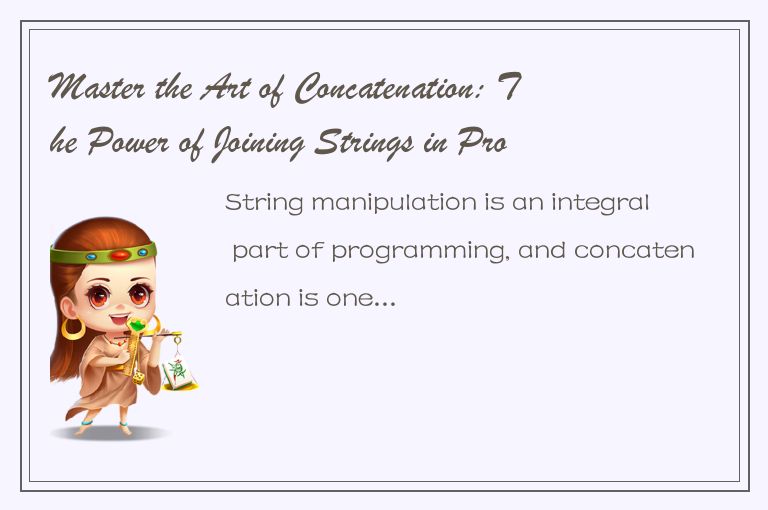String manipulation is an integral part of programming, and concatenation is one of the most commonly used string operations. Concatenation refers to the process of joining two or more strings together to form a single string.

In programming, concatenation is commonly used to build dynamic strings, such as creating a message that includes user input or generating a unique identifier. Concatenation also plays a critical role in web development, where it is often used to build URLs or form the body of an HTTP request.
In this article, we will explore the different ways to concatenate strings in programming and understand the power of this simple yet critical operation.
The Basics of Concatenation
In programming, strings can be concatenated using various operators or methods. The most common approach is to use the “+” operator, which allows us to append one string to the end of another.
For example, let’s concatenate the strings “Hello” and “World” using the “+” operator:
```
String greeting = "Hello" + "World";
System.out.println(greeting);
```
Output: `HelloWorld`
We can also concatenate strings with variables:
```
String firstName = "John";
String lastName = "Doe";
String fullName = firstName + " " + lastName;
System.out.println(fullName);
```
Output: `John Doe`
In the code above, we concatenated the strings “firstName”, “lastName”, and a space using the “+” operator to produce the fullName string.
Another way of concatenating strings is by using the “concat()” method. The “concat()” method appends the given string to the end of the string on which it is invoked.
For example:
```
String phrase = "big brown";
String animal = "fox";
String fullPhrase = phrase.concat(" ").concat(animal);
System.out.println(fullPhrase);
```
Output: `big brown fox`
This code concatenates three strings - “phrase”, a space, and “animal” - using the “concat()” method.
The Power of Joining Strings in Programming
Concatenation may seem like a simple operation, but it is incredibly powerful when used effectively. Here are some practical examples of the power of concatenation in programming:
1. Building URLs
In web development, we often build URLs dynamically based on user input or program logic. Concatenation allows us to easily generate URLs by appending strings that represent the different parts of the URL, such as the domain name, path, and parameters.
For example, let's generate a URL to search for a product on Amazon.com:
```
String domain = "https://www.amazon.com";
String path = "/s";
String parameterName = "keywords";
String searchTerm = "laptop";
String url = domain + path + "?" + parameterName + "=" + searchTerm;
System.out.println(url);
```
Output: `https://www.amazon.com/s?keywords=laptop`
In this example, we concatenated four strings to generate the complete URL for the laptop search on Amazon.com.
2. Constructing SQL Queries
In database programming, SQL queries are constructed dynamically based on user input or program logic. Concatenation is an essential tool for building SQL queries since it allows us to dynamically generate the query string based on the user’s input.
For example, let’s build a SQL query to retrieve all employees whose last name starts with “S”:
```
String query = "SELECT * FROM employees WHERE last_name LIKE 'S%'";
System.out.println(query);
```
Output: `SELECT * FROM employees WHERE last_name LIKE 'S%'`
In this example, we used the “LIKE” operator in the query string to match all last names that start with “S” and concatenated the string with the SQL statement for selecting all employees.
3. Creating Dynamic Messages
In programming, we often need to build messages dynamically based on user input or program logic. Concatenation allows us to easily generate complex messages by appending strings that represent the different components of the message.
For example:
```
String firstName = "John";
int age = 35;
String message = "Hello! My name is " + firstName + " and I am " + age + " years old.";
System.out.println(message);
```
Output: `Hello! My name is John and I am 35 years old.`
In this example, we concatenated three strings - “Hello! My name is”, “firstName”, and “age” - to generate a dynamic message based on the given variables.
Conclusion
Concatenation is an essential operation in programming that allows us to join strings together to form a single string. We can concatenate strings using the “+” operator or the “concat()” method in Java, and these operations are incredibly powerful when used creatively.
In summary, mastering the art of concatenation can help programmers build dynamic web pages, construct database queries, and create interactive messages, among other things. So next time you need to build a dynamic string in your code, consider using the power of concatenation to simplify the process!




 QQ客服专员
QQ客服专员 电话客服专员
电话客服专员